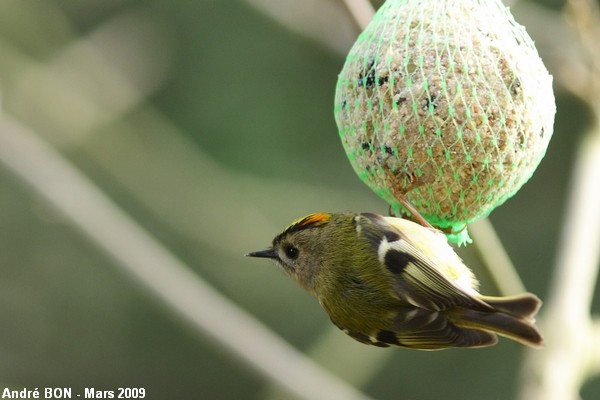


| Goldcrest (Regulus regulus (Linnaeus, 1758)) |



|
|
Scientific name: Regulus regulus (Linnaeus, 1758) Common name: Goldcrest French name: Roitelet huppé Order: Passeriformes Family: Regulidae Size: Body size: 9 cm; Weight : 7 to 9 g; This is one of the smallest bird in Europe. Habitat: Coniferous and mixed forests, parks and gardens with conifers. Food: Small insects and spiders captured on trees and sometimes on the ground. It can also feed on seeds in winter. Nesting: The Goldcrest builds a ball-shaped nest hanging high in a conifer. It has a small entry near the top. There are two broods of 7 to 11 eggs per year. Migration: Partially migratory. Geographic area: North Africa, Europe, Middle-East, Asia east to Japan. |
The Goldcrest's plumage is olive-green on the upper size and whitish beige on the under size. The wings are darker and bear two white bars. The head shows a black-bordered orange crown on males. The crown is yellow on females. The Goldcrest can rise the crown feathers into a crest when frightened. The bill is black, narrow and sharp. The Goldcrest is used to hanging upside down using its strong pale brown fingers. It uses its wide round wings to fly through the branches and even to perform stationary flight to catch insects under the leaves. Mortality can be very high during very cold winters. |
| [To know more about the Goldcrest] [Next picture] [Top] |

|
I am used to often observing Goldcrests in the pine trees of my garden. However it is difficult to shoot pictures as this small bird is always on the move. |
| [To know more about the Goldcrest] [Next picture] [Previous picture] [Top] |

|
I am not used to seeing a Coldcrest coming to feed on fatballs. |
| [To know more about the Goldcrest] [Previous picture] [Top] |

|
I think that the rather yellowish colour of the crown indicates a female here. |